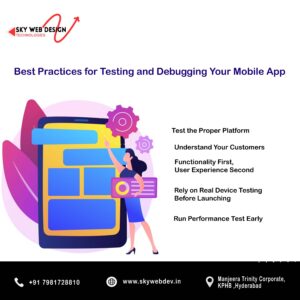- + 91 7981728810
- info@skywebdev.in
- KPHB,Hyderabad

Best Practices for Testing and Debugging Your Mobile App
Introduction
In the fast-paced world of mobile app development, ensuring your app is functional, user-friendly, and bug-free is paramount. Testing and debugging are crucial phases in the development lifecycle that help identify and resolve issues before your app reaches end-users. Given the complexity of mobile platforms, diverse device specifications, and varying user environments, a robust testing and debugging strategy is essential for delivering a high-quality app. This guide outlines best practices for testing and debugging mobile apps, helping you to enhance performance, user satisfaction, and overall reliability.

- Understanding the Mobile App Testing Process
Types of Mobile App Testing
This includes testing functionalities like user login, data entry, and integration with other services.
Usability Testing: Focuses on the user experience, checking the app’s ease of use, interface design, and overall user satisfaction.
Performance Testing: Evaluates how well the app performs under various conditions, including load times, responsiveness, and stability.
Compatibility Testing: Assesses the app’s performance across different devices, operating systems, screen sizes, and network conditions.
Security Testing: Identifies vulnerabilities in the app and ensures that data protection measures are in place to safeguard user information.
- Setting Up a Comprehensive Testing Strategy
Define Clear Objectives
Before starting testing, establish clear objectives for what you want to achieve. Objectives might include verifying specific features, ensuring compatibility with a range of devices, or evaluating performance under high traffic conditions.
Develop a Testing Plan
Create a detailed testing plan that outlines:
Scope: What features and aspects of the app will be tested.
Resources: Tools, devices, and team members involved.
Schedule: Timelines for different phases of testing.
Criteria: Success criteria and thresholds for acceptable performance.
- Leveraging Automated Testing Tools
Benefits of Automated Testing
Efficiency: Automated tests can run faster and more frequently than manual tests, covering more scenarios in less time.
Consistency: Automated tests reduce the risk of human error and ensure consistent execution.
Reusability: Test scripts can be reused across different versions of the app, facilitating regression testing.
Popular Automated Testing Tools
Espresso: A Google-developed framework for testing Android applications with a focus on UI testing.
XCUITest: Apple’s framework for UI testing of iOS applications, integrated with Xcode.
Selenium: Although primarily used for web applications, Selenium can be used in conjunction with tools like Appium for mobile testing.
- Manual Testing and Real-Device Testing
Importance of Manual Testing
While automated testing is efficient, manual testing remains crucial for evaluating the app from a user’s perspective. It helps identify issues that automated tests may miss, such as user experience flaws and intuitive usability.
Real-Device Testing
Testing on real devices is essential because emulators and simulators may not accurately reflect real-world conditions. Focus on:
Device Diversity: Test across a range of devices with different screen sizes, resolutions, and operating system versions.
Real-World Conditions: Test under various network conditions, battery levels, and other real-world scenarios.
- Debugging Best Practices
Use Debugging Tools Effectively
Integrated Development Environments (IDEs): Leverage IDE features like breakpoints, variable inspection, and logging. Xcode for iOS and Android Studio for Android provide powerful debugging tools.
Remote Debugging: Use remote debugging tools to inspect and debug apps running on physical devices connected to your development environment.
Implement Effective Logging
Detailed Logs: Implement detailed logging to capture information about app behavior, errors, and performance issues.
Log Levels: Use different log levels (e.g., info, warning, error) to categorize log messages and make it easier to diagnose issues.
Reproduce and Isolate Issues
Reproduction Steps: Document steps to reproduce bugs consistently. This helps in isolating and fixing the issue more efficiently.
Isolation: Narrow down the problem to specific components or interactions within the app to identify the root cause.
- Conducting User Acceptance Testing (UAT)
Importance of UAT
User Acceptance Testing (UAT) involves having actual users test the app to ensure it meets their needs and expectations. It provides valuable feedback on functionality, usability, and overall user experience.
Best Practices for UAT
Select Representative Users: Choose users who represent your target audience to provide relevant feedback.
Provide Clear Instructions: Give users clear instructions on how to test the app and what to focus on.
Collect Feedback: Use surveys, interviews, and observation to gather feedback and identify areas for improvement.
- Handling Performance Optimization
Identifying Performance Bottlenecks
Profiling Tools: Use profiling tools to monitor resource usage, such as CPU, memory, and network utilization.
Stress Testing: Simulate high traffic conditions to identify how the app performs under load.
Optimizing Performance
Code Optimization: Refactor inefficient code and algorithms to improve performance.
Resource Management: Optimize resource usage, including reducing image sizes and minimizing network calls.
Background Tasks: Manage background tasks efficiently to avoid draining device resources and affecting app performance.
- Ensuring Security and Compliance
Conducting Security Testing
Vulnerability Scanning: Use tools to scan for common vulnerabilities such as SQL injection, cross-site scripting (XSS), and data breaches.
Penetration Testing: Perform penetration tests to identify security weaknesses and assess the app’s resilience against attacks.
Compliance with Regulations
Data Protection: Ensure compliance with data protection regulations such as GDPR, CCPA, and HIPAA.
App Store Guidelines: Adhere to app store guidelines and policies related to user data and privacy.
- Continuous Integration and Continuous Deployment (CI/CD)
Benefits of CI/CD
Automated Testing: CI/CD pipelines automate testing processes, ensuring that code changes are validated continuously.
Faster Releases: CI/CD enables faster release cycles by automating the build, test, and deployment processes.
Implementing CI/CD for Mobile Apps
Version Control Integration: Integrate with version control systems like Git to manage code changes and triggers for automated builds and tests.
Build Automation: Use CI/CD tools like Jenkins, CircleCI, or GitHub Actions to automate builds and deploys.
Test Automation: Incorporate automated tests into the CI/CD pipeline to validate code changes before deployment.
- Managing Test Data and Environments
Creating Test Data
Realistic Data: Use realistic test data that mimics actual user data to evaluate how the app handles different scenarios.
Data Privacy: Ensure test data is anonymized and complies with privacy regulations.
Managing Test Environments
Isolation: Maintain separate test environments to avoid interference with production data and operations.
Consistency: Ensure test environments are consistent with production environments to accurately reflect real-world conditions.
Conclusion
Testing and debugging are critical components of mobile app development that directly impact the quality and success of your app. By adhering to best practices, including a mix of automated and manual testing, leveraging effective debugging tools, and focusing on performance and security, you can identify and address issues proactively, ensuring a smoother user experience and a more reliable app.
Implementing a comprehensive testing strategy, incorporating continuous integration practices, and managing test data effectively will help you deliver a high-quality mobile app that meets user expectations and performs well across diverse devices and conditions. Ultimately, investing time and resources into thorough testing and debugging will pay off in terms of user satisfaction, app stability, and long-term success.
Address: 15th floor, Manjeera Trinity Corporate, KPHB, Hyderabad 500072
Mobile No.:+91 7981728810
Email id: info@skywebdev.in
Website: https://skywebdev.in
Visit Link
- Privacy
- Terms & Conditions
Quick Links
Contact
+91 7981728810
info@skywebdev.in
Address
15th floor, Manjeera Trinity Corporate, JNTU - Hitech City Road, KPHB, Hyderabad-500072
Copyright © 2024 Sky Web Design Technologies. All Rights Reserved.